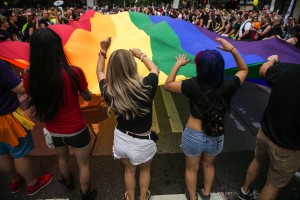LGBT: There’s more to the acronym
 Bettina Hansen
Bettina Hansen Amanda DeBlois and Carla Moreno, right, dance while helping to carry a huge rainbow flag for the 41st Annual Seattle Pride Parade in downtown Seattle on Sunday, June 28, 2015. (Bettina Hansen/Seattle Times/TNS)
In a proclamation issued at the end of May, President Barack Obama announced that, once again, the month of June 2016 is national Lesbian, Gay, Bisexual and Transgender Pride Month.
You’ve probably heard the term LGBT in the news a lot lately, especially when someone is talking about gay marriage or transgender bathroom rights. But did you know that LGBT is short for an even longer acronym?
In an effort to represent the many various identities, LGBTQQIP2SAA includes the different recognized sexual and gender identities that people commonly identify with.
But what do all those letters – and yes, there is a number in there – mean? Here is a list defining each of those different terms:

The lesbian sign includes two female symbols interlocked
Lesbian: A homosexual female. This term generally refers to women who are emotionally, romantically or sexually attracted to other women.

They gay sign includes two masculine symbols interlocked with each other. It can also be two interlocked feminine symbols.
Gay: A homosexual male. This term is most commonly used to describe men who are sexually, romantically, or emotionally attracted to other men. It is also used as a blanket term to identify all people who are attracted to others of the same sex.

The bisexual sign encircles both the male and female signs .
Bisexual (Bi): A person who is sexually, physically and/or romantically attracted to people of their own biological sex and their opposite sex.

The transgender sign combines the male and female signs together to show the variety of gender identities.
Transgender: An individual who identifies with a gender other than their biological sex. This term is a blanket term that can refer to cross-dressers, genderqueers, drag kings, drag queens or transsexuals, people who have undergone medical treatments to change their biological sex through Male-to-Female or Female-to-Male procedures.

The rainbow symbolizes LGBT pride.
Queer: A person who has a non-heterosexual normative gender identity, sexual orientation or biological anatomy. This is an umbrella term sometimes used by the LGBT community to refer to anyone who falls outside of society’s traditional sense of gender or sexuality. Note: this term has often been used negatively and so may be considered offensive to some.

The rainbow symbolizes LGBT pride.
Questioning: An individual who is unsure about or is in the process of exploring their own sexual orientation or gender identity.

The intersex sign combines the male and female signs.
Intersex: A person whose biological anatomy or physical appearance doesn’t fit the technical definition of male or female. This term may refer to a person born with the XXY gene or someone with both male and female anatomy and characteristics.

The different gender signs are joined together by a heart to represent love for all the gender identities and sexualities
Pansexual: An individual who experiences sexual, romantic, physical and/or spiritual attraction to others regardless of gender identity, expression or biological anatomy. Attraction to others is not limited to people who fit into the standard gender binary.

The Two-spirit is a Native American term
2-Spirit: A person who fulfills both male and female gender roles. This term was adopted by indigenous North Americans to indicate a person who possesses a masculine and feminine spirit within their body.

A black ring symbolizes Asexualty to represent their lack of sexual attraction to any sexuality or gender
Asexual (Ace): A person who feels little to no sexual attraction towards any group of people. Asexuality exists on a spectrum of sexual attraction and desire and individuals are still capable of having romantic, emotional or affectionate relationships with others. This identity is not to be mistaken for celibacy or abstinence.

The rainbow flag is a symbol of LGBT pride
Ally: A person who respects and supports the LGBT community and their rights. Typically applied to straight, cis-gendered individuals, this term can refer to anyone who is a supporter or stands up for LGBT rights.
Because the full acronym is such a mouthful, LGBTQQIP2SAA is often shortened to LGBT, LGBTQ+ or any combination of the terms to include the different communities being discussed.
Other common terms include:
Bicurious: similar to questioning, individuals are curious about having attraction to people of the same and different gender/sex
Cisgender: a person whose biological sex matches their gender identity, also known as a cis-man or cis-woman
Heteronormativity: The belief that all individuals are and should fall into the traditional definitions of heterosexual men and women. This concept follows the idea that the default sexuality is straight and a person’s biological sex is their true gender.
Third gender: a person who does not identify as a man or a woman but someone outside of the gender binary. This term may also refer to intersex or androgynous individuals.
Ze/Hir: Gender neutral pronouns that are used alternatively to “he/his” or “she/her”. These are generally preferred by people who don’t feel comfortable using “he/she.” The plural pronouns “they/their” are also commonly used as gender neutral terms.
It’s important to remember that all these identities are valid and real. Having an open mind and becoming educated about the wide diversity of people in the world is the first step to addressing the social issues and stigmas surrounding the LGBT community.
@miranda_lorenc

